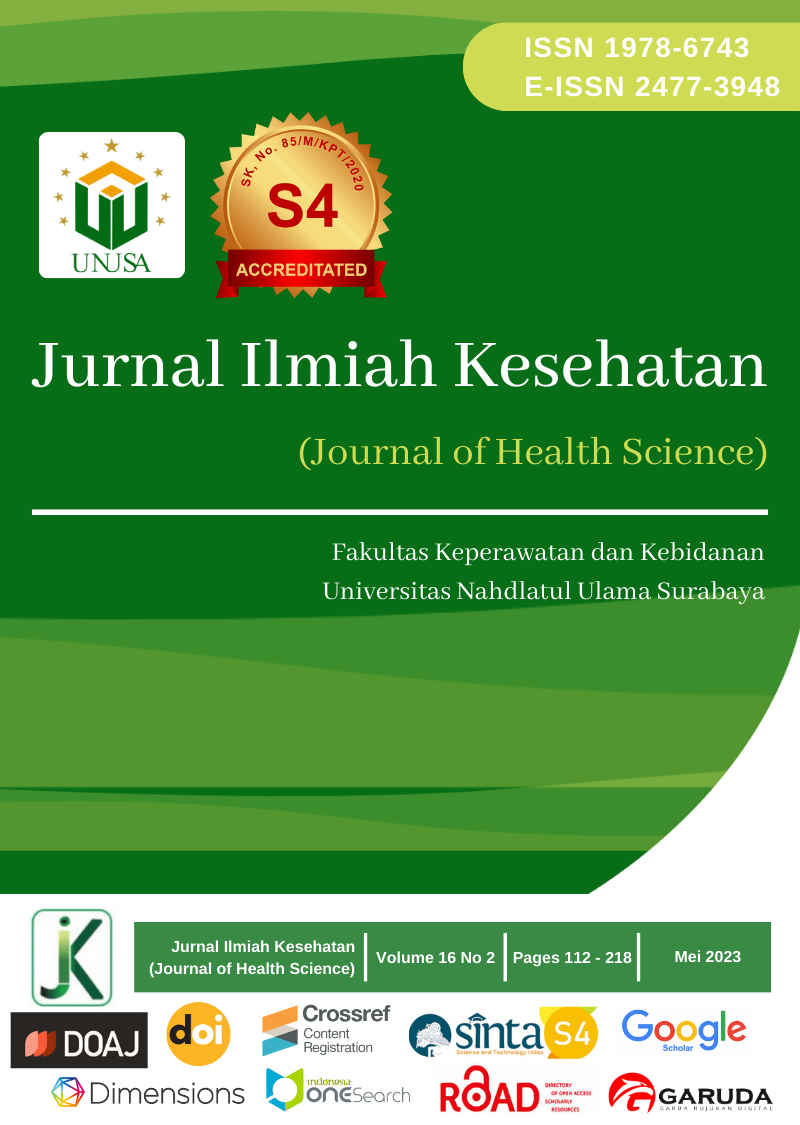Analysis of PPE Use with Occupational Disease Risk Control: Analytical Study of Ppe Use at The Sudiang Raya Public Health Center, Biringkanaya District, Makassar City
Main Article Content
Abstract
The use of PPE is closely related to occupational diseases caused by work factors or diseases acquired while doing work and occur over a long period. This study aimed to determine the relationship between Knowledge, Compliance with the use of PPE, Availability of PPE, Implementation of Standard Operating Procedures (SOP) for the use of PPE and PPE Implementation Policy with Occupational Disease Risk Control. This research is quantitative with an analytic survey approach using a cross-sectional study method. The population in this study were all health workers with a total sample of 28; the sample was all nurses/doctors and midwives. Based on the square or comparative test results to determine the relationship between occupational disease risk control. The results showed that there was no relationship between knowledge (P=0.608), there was a relationship between the availability of Personal Protective Equipment (PPE) (P=0.002), Standard Operating Procedures (SOP) (P=0.004), Compliance with using Personal Protective Equipment (PPE) (P = 0.000). There is no relationship between policy (P = 0.0604) and controlling the risk of occupational diseases. Interventions are needed to ensure the availability of personal protective equipment (PPE) such as masks, and protective goggles, adherence to the use of self- protection equipment (PPE), and the implementation of Standard Operating Procedures (SOP) in each unit requires complete control so that the Standard Operating Procedures (SOP) are implemented, and adherence to the use of Personal Protective Equipment (PPE) requires awareness/not negligence in using Personal Protective Equipment (PPE) when serving patients to avoid risks occupational illness.
Downloads
Article Details
Copyright (c) 2023 Harlina, Firman Alamsyah R, Andi Alim, Asriani Minarti S

This work is licensed under a Creative Commons Attribution-ShareAlike 4.0 International License.
References
Azzahra, K.M. (2021) Faktor-Faktor yang Mempengaruhi Derajat Kesehatan Masyarakat Menurut Hendrik L. Blum. OSF Preprints. DOI: https://doi.org/10.31219/osf.io/s57ej
Direktur Jenderal Pembinaan Hubungan Industrial dan Pengawasan Ketenagakerjaan (1997) Surat
Edaran Nomor SE. 05/BW/1997 tentang Penggunaan Alat Pelindung Diri.
Kemenkes R I (2015) Pusat Data dan Informasi kementerian kesehatan RI situasi dan analisis lanjut
usia.
Kementerian Tenaga Kerja dan Transmigrasi (1981) Peraturan Menteri Tenaga Kerja dan Transmigrasi
Nomor: Per.01/Men/1981 Tentang Kewajiban Melapor Penyakit Akibat Kerja.
Maliangkay, M.G., Rambitan, M. and Mamuaja, P. (2021) ‘Hubungan Perilaku Perawat dengan Kepatuhan Menggunakan Alat Pelindung Diri Sesuai Standard Operating Procedur di Rumah Sakit Umum Daerah Noongan’, Epidemia: Jurnal Kesehatan Masyarakat Unima, 2(2), pp. 50–55.
Menteri Tenaga Kerja (1997) Instruksi Menteri Tenaga Kerja Nomor Inst.05/M/BW/1997 tentang Pengawasan Alat Pelindung Diri.
Menteri Tenaga Kerja dan Transmigrasi (2010) Peraturan Menteri Tenaga Kerja dan Transmigrasi Republik Indonesia Nomor Per.08/Men/VII/2010 Tentang Alat Pelindung Diri.
Presiden RI (1970) Undang-Undang Nomor 1 Tahun 1970 Tentang Keselamatan Kerdja.
Sarinah, B. and Supri, E. (2015) ‘Sikap Kesehatan Kerja dengan Penyakit Akibat Kerja pada Pekerja Batu
Bata’, Jurnal Kesehatan Masyarakat, 1(2).
Sibarani, I.H. (2014) ‘Penyakit Akibat Kerja Bagi Perawat yang Bertugas di Rumah Sakit’, OSF
Preprints, pp. 1–8.
Sugiyono (2017) Metode Penelitian Bisnis: Pendekatan Kuantitatif, Kualitatif, Kombinasi, dan R&D. 3rd
edn. Bandung: CV. Alfabeta.
Supiana, N., Supriyatiningsih and Rosa, E.M. (2015) ‘Pelaksanaan kebijakan dan penilaian penggunaan APD (Alat Pelindung Diri) oleh dokter dan bidan di ruang bersalin dan nifas RSU PKU Muhammadiyah Yogyakarta Unit I Tahun 2014/2015’, JMMR (Jurnal Medicoeticolegal dan Manajemen Rumah Sakit), 4(1), pp. 1–19.
Zahara, R.A., Effendi, S.U. and Khairani, N. (2017) ‘Kepatuhan Menggunakan Alat Pelindung Diri (APD) Ditinjau dari Pengetahuan dan Perilaku pada Petugas Instalasi Pemeliharaan Sarana’, Jurnal Aisyah: Jurnal Ilmu Kesehatan, 2(2), pp. 153–158. DOI: https://doi.org/10.30604/jika.v2i2.60
Zaki, M., Ferusgel, A. and Siregar, D.M.S. (2018) ‘Faktor–Faktor yang Memengaruhi Penggunaan Alat Pelindung Diri (APD) Tenaga Kesehatan Perawat Di RSUD Dr. RM. Pratomo Bagansiapiapi Kabupaten Rokan Hilir’, Excellent Midwifery Journal, 1(2), pp. 85–92.
Zebua, M.C.P. (2020) ‘Pencegahan Penyakit Akibat Kerja Pada Perawat’, OSF Preprints, pp. 1–7. Available at: https://doi.org/10.31219/osf.io/hpg9j. DOI: https://doi.org/10.31219/osf.io/hpg9j





